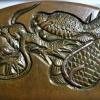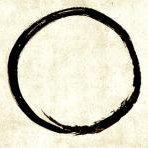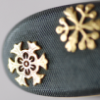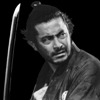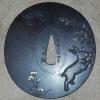Leaderboard
Popular Content
Showing content with the highest reputation on 08/23/2021 in all areas
-
5 points
-
5 points
-
1. Start with this: https://www.amazon.co.uk/Study-Japanese-Swords-Chronological-History/dp/1954297254/ref=sr_1_1?dchild=1&keywords=yurie+endo&qid=1629717175&s=books&sr=1-1 2. Then move to this https://www.amazon.co.uk/Connoisseurs-Japanese-Swords-Kokan-Nagayama/dp/4770020716 3. Then, if you have energy and desire: http://www.shibuiswords.com/kozaAFU.htm4 points
-
As each Koshirae is custom made for a blade it will be difficult to find one that will be a good fit. Also if the blade is a nice polish the last thing you want to do is stick it in an old Saya full of old oil, dirt etc etc.4 points
-
Fellow Nihontophiles, Just saw this in an unrelated trawl: https://www.wsj.com/amp/articles/BL-SEB-88753?responsive=y The article hits a paywall but the introductory text reads: ======================================================================================== THE WALL STREET JOURNAL ‘Daughters of the Samurai’ Sheds Light on a Strange Chapter in U.S.-Japanese History By Barbara Chai May 19, 2015 3:00 pm ET In 1871, five Japanese girls were sent to live and study in the U.S., and become versed in Western culture. Their mission was to immerse themselves in Western customs and education, so they could one day return to their native, Meiji era Japan and share what they had learned. The two oldest of the five girls, who were between 6 and 14 years old, struggled upon arrival and left the U.S. soon after. But the remaining three -- Sutematsu Yamakawa Oyama, Ume Tsuda and Shige Nagai Uriu, all from samurai families -- stuck it out,... ======================================================================================== BaZZa.3 points
-
Hi Ron, What John said and: your shirasaya is the best protection for the blade so you want to keep it there, which means that you can go ahead and buy an older koshirae that you can display next to your blade in shirasaya but never try to put the blade in the koshirae. This is far less expensive than having koshirae built to fit your blade, which means you can get better quality koshirae than you would have been able to afford had you built the koshirae to fit. Grey3 points
-
The large characters - Seishu Iwami (no) Kami Kunisuke 勢州石見守国助 Bottom right - Jidai Kanbun Bottom left - shoshin3 points
-
No, most of the Gendai ratings were arbitrarily given and do not necessarily reflect their value or workmanship compared to others. There is a fairly large amount of discussion on this in other threads if you do a search on the forums. https://yuhindo.com/ratings.html3 points
-
Shinsakuto daisho by Gendai swordsmith Iyo Matsuyama Ju Seiken - Dated July 1988 Katana and wakizashi in full koshirae, along with shirasaya and koshirae insert for saya, and matching brocade sword bags. (pattern pictured behind menuki photo) Kogatana with the wakizashi. Simple fuchi-kashira with mountain/shrine theme tsuba and kirin menuki. Polish on both blades is pristine. No damage and have never been used to cut. Both sword still have ubu-ba. Impressive swords in both size and weight - gunome midare with heavy sunagashi and kinsuji worked in the ha. "The real name of the Yasuken (Yasukuni) swordsmith is Gouda Toshiyuki, born in 1926, living in Heiwa-dori, Matsuyama, Ehime. He learned Soshu-den from the family of living national treasure swordsmiths Tsukiyama Teiichi and Takahashi Sadatsugu, and was introduced to the swordsmith Torio Hiromasa in 1939. In 1944, he began making swords at the Torio Gunto Forging Factory. In 1970, he was introduced to Sakai Shigemasa, who further refined his sword making skills. He is a member of the All Japan Swordsmith Association and has received many awards including the Special Prize and the Award for Effort." According to this resource, this smith has been papered by either the NBTHK or NTHK. https://www.japaneseswordindex.com/gendai.htm Please see attached photos of blade in hand, as well as the original photos from the seller in Japan, which include specs/dimensions. Additional specific photos available upon request. Please PM with specific questions. Looking to ship/sale within the continental United States. $7500 shipped/insured. A couple link examples of the same smith from other vendors: https://www.aoijapan.net/wakizashi-iyo-matsuyama-ju-seiken-hori-dosaku/ https://www.trocadero.com/stores/meijibijutsu/items/1215403/Katana-Koshirae-by-Iyo-Matsuyama-Ju-Seiken https://www.e-nihontou.com/html/upload/save_image/esg20101158049314589.jpg2 points
-
If you can post some pictures showing any details of the blade, the people on here are really good at providing the region it was made and possible dates. The more detail and definition you can get, the better info they can give you. Also, if you provide a picture of the whole blade (without the fittings) from square-on, it will help them because the shape of the blade provides a lot of info about location/date. Note, I say "they" because I'm new to this too, and in awe of the fact that they can give so much info just from photos! Jon Edit: Geraint beat me to it!2 points
-
Thank you all for the advice. No worries about me doing any of the work. It will all be professionally done. My father told me years ago, 45 or so, to never touch the blade. I listened. It is in fairly good shape but I would like to have it polished and restored to the level that it deserves. I will lightly oil the blade with mineral oil tonight. Should this be applied to the tang as well or just the blade. I am ignorant to the world of Nihonto but respectful of what I have been blessed to receive it and will that treat it as it should be treated. Unfortunately my father never knew what he was in possession of.2 points
-
Dear Mark. As Dan says this one seems to read Shigemasa and it is not a WWII sword but rather earlier. It is in civil mounts which have been adapted for use in the war by the addition of a loo for the tassel and a ring to the scabbard to suspend the sword from, it may have originally had a leather combat cover. The fittings are quite nice and the condition of the blade looks fairly good given it's history since the war. Resist the urge to clean anything, just keep the blade lightly oiled. If you measure from the tip to the notch on the back of the blade where the metal collar sits what length do you get? All the best.2 points
-
Hi Alton, The main centres of sword production in the Muromachi period were Bizen and Mino provinces. The popularly held view is that a flood of the Yoshii river in 1590 wiped out a big part of the Bizen production so that when things settled down after Sekigahara many of the remaining smiths had their roots in the Mino tradition and this greatly influenced the sword schools that came into being in the early shinto period. See Markus Sesko's take on the flood thing here: https://markussesko.com/2013/03/12/the-great-flood-of-the-yoshii-river/ Their was an antiquarian movement around Keicho which revived the sugata of the nanbokucho period, whether it did or attempted to revive their production methods, is another thing. Certainly the ability to produce swords with utsuri was largely lost. The Satsuma school decided that the Keicho sugata suited their view of what a well-armed samurai should be swinging and they kept with this through to shinshinto times. That's not to say that they never deviated from it, but they were greatly influenced by the Keicho shinto sugata whereas elsewhere things moved on with the other sugata that were adopted in the 17th century. As regards shinto Hizen swords, the core style of the founder of the school, Tadayoshi, was aimed at reproducing the works of the Rai school from the late kamakura and early nanbokucho period and this influenced the works of the later smiths. Swords with elegant sugata, suguba hamon and finely forged ko itame (konuka hada as it became known) predominate. An article here on smith-produced steel in swords which gives a picture of what happened in terms of steel production in the shinto period: https://markussesko.com/2018/09/30/oroshigane-mentioned-in-signatures/2 points
-
That makes more sense figured it was a old system. Thank you for the quick response and the link much appreciated.2 points
-
Dear All, The Japanese Armour Society is pleased to announce our next webinar presentation scheduled for Sunday, September 26, 2021 at 15H Paris Time. For this presentation, we have a special guest, Chris Glenn who will be presenting an overview of the Battle of Sekigahara, the largest and most important event in Japanese feudal history. This lecture will include specific examples of armour that was used at this great battle and there will be opportunity for Qs & As. Chris Glenn is a Nagoya based, Australian born radio DJ, TV presenter, speaker, narrator, MC, author and historian. Chris is also the Sekigahara Tourism Ambassador, the Nagoya Tourism and Cultural Exchange Ambassador, and the Omi Tourism Ambassador. And last but not least, Chris is a collector of samurai armour and weapons. Needless to say, this lecture is an event not to be missed! Please note that in an effort to publicize the initiatives of the Society, and to provide a sampling of our membership offerings to those outside of the Society who may be interested in our activities and are considering membership, we will be opening this webinar to the general public. However, please note the following requirements: In order to access the webinar, all attendees must have a Zoom account All attendees will be required to register with their real names and country of residence Once their registration has been approved, attendees will be given an access code to the webinar By registering for the webinar, all attendees agree to not make any recordings or screenshots of the presentations All content of the webinar remains the property of the Japanese Armor Society and/or copyright holders of the images contained within the presentations and cannot be reproduced without the expressed written consent of the JAS and/or the copyright holders Please note that the webinar is restricted to 100 persons only, and thus registration/participation will be allocated on a first-come, first-served basis, with JAS members having priority over non-members. When: Sep 26, 2021 03:00 PM Paris Topic: The Battle of Sekigahara Register in advance for this webinar: https://us02web.zoom.us/webinar/registe ... BBvQyd5OBw After registering, you will receive a confirmation email containing information about joining the webinar.1 point
-
Good Morning to you all... from a quiet, peaceful Sunday Morning in Hawaii I was reading one of my favorite Thread on NMB" , "What Makes Koto Swords So Desirable" , and, Chris H. posted these interesting " Tongue and Cheek " nuggets ( Thanks Chris) Being ignorant, ( rather than being arrogant ) for my level of Nihonto knowledge, I thought it was humorous . But, " My ignorance caused me problems, again " ... May I please ask... Can someone tell the history/facts of each of these " Nuggets " ? <><><><><><><><<><><><><><><><><><><><><><><><><><><><><><><><><><><><><><><><><><><><><><><><><> Some nuggets: Late Muromachi, Seki methods spread and dominate during Shinto times, leading to loss of school-level variations. Brief Momoyama effort to resurrect the old methods, fades quickly. Some of it lives on in Hizen in a parallel universe. Shinto peace times reinforce the non-utilitarian aspect of swords, craft is driven by fades and fashions which are disconnected from function. Centralized Tamahagane production leads to loss of regional specificity in iron Reduction in demand for swords during Shinto times leads smashes the right tail of the distribution of geniuses which would have turned grand-masters. Shinshinto Masahide revival starts from scratch after observations that swords are no longer functional. Two generation, destruction test on Naotane swords reveal that the Masahide school wasn't successful in returning functionality. Mozart Kyomaro manages to reproduce some of the beauty of old Koto but then dies young and full of debt. Sword ban strangulates the craft even further... <><><><><><><><><><><><><><><><><><><><><><><><><><><><><><><><><><><><><><><><><><><><><><><><><>1 point
-
Yesterday I have picked up an army sword and the koshirae is really nice but the kojiri is replaced. It looks like a field or local repair. The sword was brought back from the Dutch East Indies shortly after the war. Anyone seen this kind of repairs before? I don't know if the replacement is done during the war of after. It shows some age. All opinions are highly appreciated! Regards, Ed1 point
-
Mark, the date is May 1944. Someone will help with the smith. Would you mind taking a look at the back edge of the nakago to see if there are any stamps or numbers? Also, are the metal fittings stamped with any numbers?1 point
-
Trust me, this is only the beginning! It is a fascinating subject and one which can all too easily become, if not an obsession, then at least a lifelong interest. I stumbled across my first Japanese sword when I was about fourteen, still have it and still have the interest. All the best.1 point
-
The Ishizuke (end cap that fits over the Kojiri *tip of saya - correct me, if I am wrong on this) is kind of cool and distinctive, in my opinion.1 point
-
Hi Mark. Better pictures as mentioned in the other thread might give us some chance of getting this to at least a time period. In the end, if you really want to know more then you will have to go down the route of professional restoration and what is called shinsa, a panel of Japanese experts inspect the sword and attribute it, (if you are very fortunate!), to a specific smith. In the case of your sword they are likely to only give a confirmation of the smith and the period in which it was made. Take it slow, time is on your side and you have started on a journey with no end so enjoy the ride. All the best.1 point
-
I get the same problem as Barry, before when I clicked on the « Unread content », I went directly to the last unread posts of a topic, now I go to the first page, first post.1 point
-
There are nine Shigemasa smiths listed in Markus Sesko's bood Swordsmiths of Japan. Some are in Bizen, others are in Seki, Bingo, Sagami.... is there a way to determine which one it was? The only thing on the Tang is the name. I have checked both sides. I feel like a kid with 5 bucks in a candy store. This is so exciting. I really do appreciate all of the help and information.1 point
-
1 point
-
1 point
-
Late join, as I've been distracted for a bit. Yes, that video is a work of art itself. My introduction to tsuba was 1989 at the apartment of a collector. He set up a small film projector and we watched a reel of film about Yonemitsu making one of his Hayashi Matashichi inspired mon tsuba with extensive Higo Zogan. From the film quality and techniques, I would guess it to have been early 1960s. Forward about 50 years and your Katsuhira video sets up the West gate to quite a journey. It is a great companion and yet contrast to the Yonemitsu video. The two videos create quite the story arc.1 point
-
Outstanding Neil, one of the finest collections I've ever seen. Cheers1 point
-
1 point
-
Keen to see the others you decided to keep if they are as nice as this.1 point
-
EDIT to the above; FYI I put this string into google and there is quite a lot on these three ladies: Sutematsu Yamakawa Oyama, Ume Tsuda and Shige Nagai Uriu BaZZa.1 point
-
Thats one hell of a request On the subject of Seki into Edo, steel gets better and so does mei, but, lacks so much of the Muromachi.1 point
-
Hi Gulio and welcome. This is a patch of clustered ara-nie with a tendency towards nie kuzure. These form large crystals of standing-out nie that are discernible easily to the naked eye. What's occurring here is that the hardening process fluctuates between nie and nioi, with unevenness in the expression, density, and size of the nie crystals. This can be due to either materials being unevenly mixed, or to the quenching temperature differential between slightly different between sections of the blade. The ara-nie of smiths such as Shizu Kaneuji is a valuable kantei point, and considered a positive trait and deliberate (i.e. reflecting the smith's intention). Ara-nie has a strong presence in the mino tradition, and later in Shinto (which was inherited from Mino, broadly speaking). As you move away from Kaneuji, Ara-nie is considered more accidental than deliberate. Hotsure appears as fraying threads of fine nie crystals, typically a trait of Yamato-den. Nijuba you'll fine as a parallel repetitions of the nioiguchi, typically on early Bizen tachi and Yamashiro work more generally. Hope this helps, good luck in your study. Don't hesitate should have any questions.1 point
-
1 point
-
I apply oil with a piece of facial tissue (paper). I remove oil 1st with another piece of tissue, to get the most of it, and then with microfiber. Grey1 point
-
Item No. 96 - Iron Tsuba with gold, shakudo , copper and silver 8.30 cm x 8.70 cm x 0.38 cm Subject of bat in moonlight with cutout details of clouds and fog , plants and grasses to front and rear - mumei Unusual Octagonal shape with lots of detail . Thought to be late 18th cent. Bought nearly twenty years ago from a European Collection Item No. 97 - Iron Tsuba 6.56 cm x 6.04 cm x 0.51 cm Subject of bat in clouds ? Am I just being fanciful , or does the lower cutout represent a bat ?1 point
-
Duuh! Thanks Mal...I'll go have a look.... Wow just opened it...great work Mal....I will spend Sunday reading both of those articles. Regards,1 point
-
Judging by this picture of the backside alone the steel looks very homogeneous. Most probably Owari-style from Edo-Period. Best, Florian1 point
-
Geoff, Great topic for research! I have to admit I did not know there were navy certified smith’s, or a list of them, which you would assume there would be a list. I hope you get some answers. If not, good luck with the research, we will all benefit from what you find.1 point
-
Volker is a friend and I have bought and sold swords from and to him. He is also a true expert on shrine swords from Yasukuni and Minatogawa. Good to see you on here Volker!1 point
-
平安城住藤原國道 Heian-jō jū Fujiwara Kunimichi It means "Kunimichi Fujiwara, resident of Heian Castle" made this. He wasn't actually residing in a castle. "Heian Castle" is just another name for the city of Kyōto. Any pictures of the actual blade itsel? The signature is nice, but I bet the blade is even nicer.1 point
-
When I click on a topic it takes me to the first post in the thread not the last.1 point
-
Item No. 94 - Iron Tsuba 64.0 cm x 53.5 cm x 0.45 cm Iron sukashi tsuba for tanto - evidence of being mounted on numerous occasions Has a ' feel ' of a 17th cent. piece Item No. 95 - Iron Tsuba 9.21 cm x 8.83 cm x 0.35 cm One piece iron tsuba thin plate but heavy because of large size. Signed - Yatsuhiro Third Generation Jingo Made This tsuba is made from a single piece of iron with the dimension at the centre the same as the mimi. The metal has been carved away in order to allow the mimi to stand proud , rather than forging a lip on the edge . Quality piece of work as you would expect from the adopted head of the family . Haynes 02039.0 name - Nagayoshi ( 1691 - 1777 ) NBTHK papered1 point
-
1 point
-
Careful what you say - he might start thinking that he's good at it...1 point
-
(DISCLAIMER: the following is just meant to answer the OP’s question in the most unfair, dishonest way and shouldn’t be taken literally. What the previous posters say about Koto swords is true and this shall only be taken as a caustic reply in which most, if not all is exaggerated!) Soooooo! What makes Koto swords so desirable? Let me be, for a moment, the fly in the ointment! 1) TRADITION: just as everything was “better before”, so it is with swords. Japanese swords were made by a very rigid society that engendered a rigid hobby. So obviously, past and venerable techniques are necessarily better than newer ones, even if, at the time, they were only dictated by what swordsmiths had at their disposal. 2) PRIDE: have you ever heard someone boasting he’s driving a Peugeot? Nope! People who drive Ferrari do! Same here! It’s always more delightful to awe somebody by saying:” I have a 700 year-old sword” than: “I have a 70 year old sword”. The worst of the shame being : “I have a Chinese wallhanger!” 3) SLOTH: let’s face it, Koto swords are easier to study than Shinto swords. Learning about 5 traditions is always easier than learning a multitude of traditions. 4) FAKE NEWS: everyone knows Kamakura and Nambokucho swords were perfect! No, really! They had beauty, grace, efficiency... wait? Efficiency? They were so practical and efficient that they had to be suriage during the Sengoku era to be useful in battle. 5) SIZE MATTERS: Everyone knows Shinto swords are useless because they weren’t made for battle but to display showy qualities. Not so with Koto swords! Eeeerrr! What about those Nambokucho swords where samurai from the Southern and Northern court fought to see who had the longer one? I mean the sword, right? Isn’t that being showy? 6) SCARCITY: actually, this is my only serious argument, so no joke here. Most of the swords on the market today are Shinto swords. It’s logical. After all, they are more recent, didn’t experience real battle, so it is normal that we find an array of swords ranging from bad to excellent. Now, the early Koto swords are more scarce. It’s logical too. They’re older so had many more opportunities to be lost, destroyed, whatever. So it’s also logical to postulate that most of those that survived were cherished family swords of quality. If this is the case, we can also postulate that many swords of lower quality disappeared in the maelstrom of time, leaving only the upper quality swords. Thus, those Koto swords we have are truly better than the more recent ones because the good ones are the only one left! Once again, anyone feeling piqued by my post, please read the disclaimer and realize this was written with a very humorous effect in mind! Please don’t send an evil ninja to exterminate me! In the end collect what you like and attracts your eye until you stumble upon your own personal treasure.1 point
-
Longest running debate in Nihonto. Nothing to ad. Great works can be found across all the era's. The accepted rule is that the better Koto era blades are better works than the other era's. In the end it's going to come down to what appeals to any one collector and what they are after/find they desire.1 point







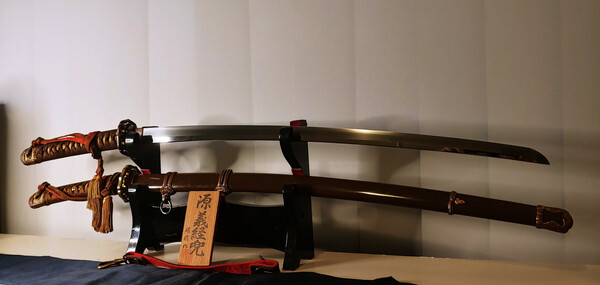







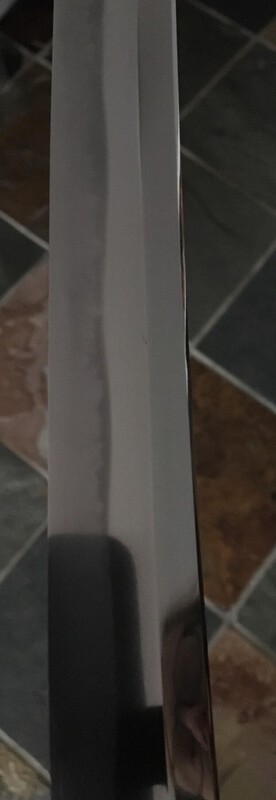




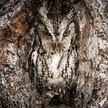


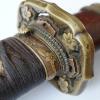







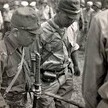

.thumb.jpg.bc10b59027a00aa142dce0349f3ba9e0.jpg)


